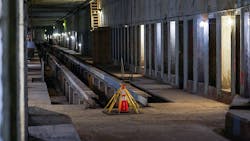OP-ED: Washington financing of the $6.9 billion Second Avenue Subway Phase 2 is still not a done deal
There is still much more for the New York Metropolitan Transportation Authority to do after U.S. Department of Transportation Secretary Pete Buttigieg and U.S. Sen. Chuck Schumer (D-NY) announced that the Federal Transit Administration (FTA) granted permission for the $6.9 billion Second Avenue Subway Phase Two project to the enter the second phase of the Capital Investment Grants New Starts program, which is final design and engineering.
The devil is in the details.
Approval to enter final design and engineering is a not a legal commitment from FTA for future funding. Going forward, it does place a cap on the amount of federal participation. This is significant as the MTA in the FTA CIG New Starts process had previously been looking for $2 billion from Washington. In April 2019, the MTA claimed it could save between $500 million to a $1 billion in costs for this project. This would have reduced the overall tab to $5 billion. Promised cost savings were based upon reduction in excavation for the 125th Street Station and building the 116th Street Station in space no longer needed for other project work.
Under the $51 billion 2020 - 2024 Five Year Capital Plan, the overall cost reflected a $1 billion increase. Instead of finding any savings, the project price tag grew to $6.9 billion. The MTA raised the proposed federal share to $3.4 billion. The MTA proceeds with design and engineering work at its own risk. Until FTA offers the MTA a Full Funding Grant Agreement, we will not know what the final amount of any approved funding from Washington will be.
Going forward, the FTA will continue a review of the MTA's technical, legal and financial capacity to implement the project. This would include ongoing updates to the final project scope, budget, schedule, project management and fleet management plans. Cost and schedule must be updated to reflect today's market condition and construction schedules.
The MTA must also be in continued compliance with a number of Civil Rights requirements. This includes their Title VI, Equal Employment Opportunity (EEO), Disadvantaged Business Enterprise (DBE) and Americans With Disabilities Act (ADA) programs all approved and proceeding in accordance with FTA rules and regulations. NYC Transit might need to purchase additional rolling stock and modifications to existing or construction of new rail yards for maintenance and storage of equipment necessary to support this new service.
The most critical issue to be resolved is identifying and securing the $3.5 billion local share toward the total project cost. It is a basic legal requirement. This is needed to leverage any future FTA capital funding under an approved Full Funding Grant Agreement to support advancement of the project. The MTA must also demonstrate that they have the financial capacity to pay for any unanticipated cost increases or funding shortfalls.
What happens if Congestion Price Tolling, along with Albany and city hall do not contribute what was expected of them? These revenues were supposed to make up $15 billion of the $51 billion MTA 2020 - 2024 Five Year Capital Plan. The MTA $51 billion 2020 - 2024 Five Year Capital Plan was adopted in late 2019 under the assumption that $15 billion would come from Congestion Price Tolling. Not a dime will appear until June 2023 or later. How will the MTA raise $15 billion over 18 months rather than five years? Will the MTA still be able to provide $3.5 billion in local funding to leverage $3.4 billion or more from Washington to pay for the $6.9 billion Second Avenue Subway Phase 2?
In addition to advancing design and engineering, more time is still needed for completion of all business relocation, real estate acquisition and private property easement rights. Agreements with NYC and various owners of underground utilities including water, sewer, gas, electric, steam and cable need to be finalized before being ready to commence construction. Successful completion for all of the above may still require many more months.
Will the MTA make public a detailed ongoing project schedule that will reveal current future status for completion of these tasks? This would tell us what time is required for each task. Once all of this work is done, upon receipt of the FTA FFGA, the MTA would be in a position to advertise, award a bid and issue a notice to proceed to the winning contractor(s). Construction contractor(s) will need several months to mobilize forces and materials before the first shovel goes into the ground for start of Second Avenue Subway Phase Two.
Resolution for all of the above would go a long way in convincing FTA that the MTA $6.9 billion Second Avenue Subway Phase Two is a real shovel ready project with secure local funding in place to qualify. This could result in a FTA FFFGA in 2023 or 2024 followed by the start of construction.
FTA in offering the MTA a FFGA for this project in future years would cap the level of federal participation. In addition to providing local match against federal dollars, the MTA would be responsible for any cost overruns above the agreed upon FFGA project cost. Remember the original Full Funding Grant Agreement between the Federal Transit Administration and MTA for the Long Island Rail Road East Side Access to Grand Central Terminal was approved in December 2006? The FFAG provided $2.63 billion of FTA grant funding toward a $6.3 billion project cost remains unchanged (virtually all of which has already been spent) with the MTA as local sponsor having to cover the $5 billion and growing cost overruns.
------
Larry Penner is a transportation advocate, historian and writer who previously worked for the Federal Transit Administration Region 2 New York Office. This included the development, review, approval and oversight for billions in capital projects and programs for the MTA, NYC Transit, Long Island Rail Road, Metro North Rail Road MTA Bus, New Jersey Transit along with 30 other transit agencies in NY & NJ.
About the Author

Larry Penner
Larry Penner is a transportation advocate, historian and writer who previously served as a former director for the Federal Transit Administration Region 2 New York Office of Operations and Program Management. This included the development, review, approval and oversight for billions in capital projects and programs for New Jersey Transit, New York Metropolitan Transportation Authority, NYC Transit bus, subway and Staten Island Railway, Long Island and Metro North railroads, MTA Bus, NYCDOT Staten Island Ferry along with 30 other transit agencies in New York and New Jersey.
